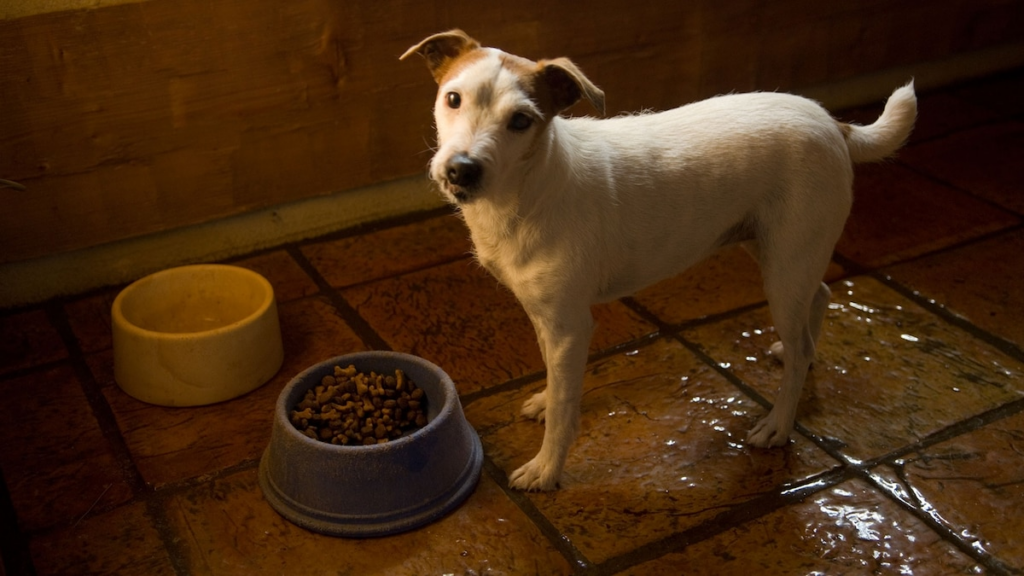A dog stands before a dish in Bartlesville, Oklahoma. Canines can be territorial about resources, such as food and living space.
We ask experts to decode the mysterious activities of our furred and feathered friends.
It's the new year—what better time for taking a fresh look at our funky pets?
We took some of our readers' pet questions to animal behaviorists for translation, and hope their answers gives a few furry—or feathered—friends a happier 2018. (Read why pets are so good for us.)
Gaia Restrepo calls Priprie, her female pearly conure—a small emerald green parrot native to Brazil—"the Queen of Mirrors."
"She loves looking at her reflection" in mirrors throughout the house, Restrepo says, but Restrepo asked us why the parrot has been acting particularly aggressive toward a mirror in her cage.
A blue budgrerigar—also known as a common parakeet—checks itself out in the mirror.
For starters, Priprie doesn't know it's her—self-recognition is rare among animals, says Bob Mulvihill, an ornithologist at the National Aviary in Pittsburgh. Among birds, only pigeons and magpies understand that the animal in the mirror is themselves. (Related: "What Do Animals See When they Look In the Mirror?")
Pigeons even recognize themselves in a video after a delay of seven seconds.
So despite their smarts, parrots aren’t known to recognize their reflections, Mulvihill says. It’s likely Priprie either sees her reflection as a potential competitor—hence the aggressive activity—or a potential friend.
If she were to gently nibble at her reflection, that would be an example of a friendly behavior called "allo preening," or grooming another individual, Mulvihill says.
As advised by Bob Mulvihill, Restrepo put a perch for Priprie near a mirror.
Since Priprie’s obsession with mirrors isn’t destructive or harmful, Mulvihill suggests providing her with a perch by the mirror so she can enjoy the extra "company."
When my cat, Wasabi, watched some made-for-cats videos featuring flitting, chirping birds, he got so excited he bit the screen.
Obviously he liked the show, but I wondered if visuals-only stimulation, like TV or laser pointers, can be frustrating, since he can’t actually catch anything.
John Bradshaw, an expert in cat behavior at the U.K.’s University of Bristol, says by email that while there is no research on the subject, cats may get annoyed because they can't actually touch—or attack—what they're seeing. (Read surprising things you never knew about your cat.)
That's especially true because “play behavior is so closely related to predatory behavior in cats," Carlo Siracusa, of the University of Pennsylvania School of Veterinary Medicine, adds by email.
General Boots, a mixed-breed cat, at the Capital Humane Society in Lincoln, Nebraska.
Neither expert said this frustration is harmful to your cat, and emphasized ways to enhance play. For instance, to keep your cat happy watching TV, Bradshaw suggests keeping toys by the screen. Siracusa keeps treats nearby when he entertains his cat with a laser pointer.
Joyce Jefferson wondered why her dogs urinate in their food dishes if they’re not collected right away.
It’s not a food review.
This is likely a territorial marking behavior, “either [on] the area where the dog eats, or the actual bowl,” says Leticia Fanucchi, an animal behaviorist at Washington State University.
Because Jefferson has more than one dog, the canines are likely competing for resources—whether it's food, dishes, or space. (Read why your dog eats poop.)
In some cases, underlying anxiety or being bullied by another dog can trigger a pet to mark its territory. Feeding pets in separate areas can help, Fanucchi says, and so can using ceramic or stainless steel bowls instead of plastic, which retains a dog’s odor.
We’re so thankful our friends just put wine charms on their glasses.
Have a question about the weird and wild world? Tweet me or find me on Facebook. Weird Animal Question of the Week answers your questions every Saturday.

